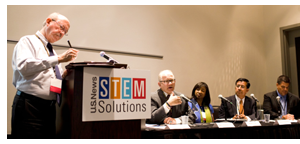A Brief Report from STEM Solutions 2013
From Rick McMaster
  I attended the U.S. News STEM Solutions 2013 conference in June. The theme of this second gathering of the national STEM community was “Teach, Inspire, Hire”. But this does not convey the true breath of the experiences that were shared at the conference. This year I saw much more of the “feet on the ground”, lessons learned that the participants could take back with them and put into action immediately. I attended the U.S. News STEM Solutions 2013 conference in June. The theme of this second gathering of the national STEM community was “Teach, Inspire, Hire”. But this does not convey the true breath of the experiences that were shared at the conference. This year I saw much more of the “feet on the ground”, lessons learned that the participants could take back with them and put into action immediately.
 The panel format for most of the sessions allowed an excellent exchange of views, among both the panel participants and the audience. Each of the sessions that I attended allowed a significant amount of time for comments, questions, and answers. The discussions among the audience members and panel participants continued well past the end of the session. The panel format for most of the sessions allowed an excellent exchange of views, among both the panel participants and the audience. Each of the sessions that I attended allowed a significant amount of time for comments, questions, and answers. The discussions among the audience members and panel participants continued well past the end of the session.
Eight simulaneous sessions made it difficult to choose a panel. I’ll provided a brief summary of the ones that I attended. Some of the panels and keynote panels will be available in audio or video format in the future on the STEM Solutions web site.
Toddlers to Techies: Getting an Early Jump on STEM
This is one of my favorite topics – we need to start early! The key points that I took from this panel session were:
- We need to educate not just the children but the adults.
- Don't be afraid to introduce big words and concepts.
- Young children can and will use engineering.
- Foster innovation, creativity, and perseverance.
- We need science and math specialists in K-5 as we have art, music and physical education specialists.
- We should develop complementary after school materials.
STEM Majors: Making Those First Two Years Count
We lose too many STEM majors early in their college careers. Here are a few of the comments from the panelists:
- We need experiential learning through all eight semesters, not just the later ones.
- Cluster students, led by upperclassmen, to reduce attrition.
- Excellence in teaching values the success of students.
- Introductory courses are gateways not gatekeepers.
Blended Learning, Flipped Classrooms and Other Innovative Teaching Techniques
I’ve been involved in blended learning for many years as the technology evolved and have seen numerous successes. I have seen a number of flipped classroom and am excited about this direction. (I always said that I learned more in my physics labs than I did in the lectures.) This panel had the most controversy among the ones that I attended but that brought out some good points:
- Why are we using lectures at all; we learn by doing , struggle and learn.
- Personalized education is now available to everyone.
- We can provide opportunity to those who would not be able to otherwise benefit.
- Maximize the helping time but giving the students space. Part of learning is failure.
- More focused research needed on flipped classrooms; it works for some but not all. A flipped classroom is not the answer; Project Based Learning is.
Business and Higher Education: Responding to STEM Workforce Needs
- The three key words are recruit, train, retain.
- Business needs have evolved and continue to do so. The skills needed have shifted.
- Internship programs are key. They give the students a look at the company, its environment and culture, and can help with retention.
- Soft skills are important and can be acquired through academic preprataion and mentoring.
As I mentioned, recordings of some of the sessions will be available in the future to allow you to view all that may be of interest.
 U.S. News STEM Solutions 2014 is being held in Washington, DC, April 23-25 in collaboration with the USA Science & Engineering Festival on April 26-27. So save that date for a family trip. There will be something for all of us. U.S. News STEM Solutions 2014 is being held in Washington, DC, April 23-25 in collaboration with the USA Science & Engineering Festival on April 26-27. So save that date for a family trip. There will be something for all of us.
Until the next issue and, as always, your comments and suggestions for future columns are welcome, @drkold.
Rick McMaster is the STEM Advocate at IBM’s University Programs Worldwide.
Back to newsletter |